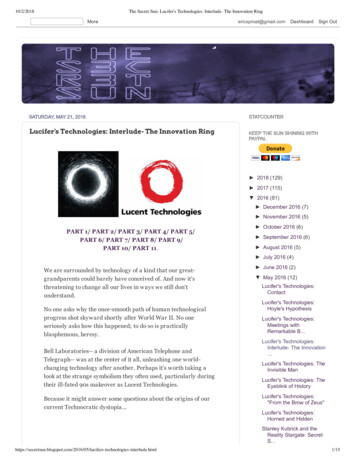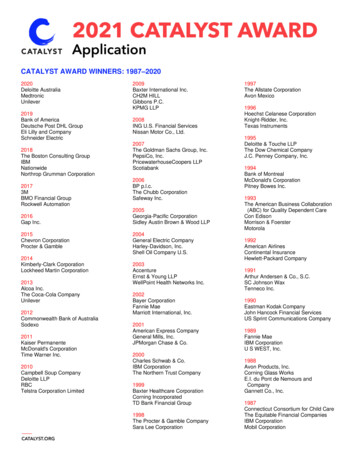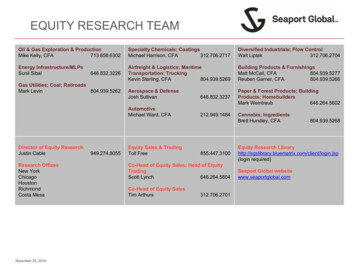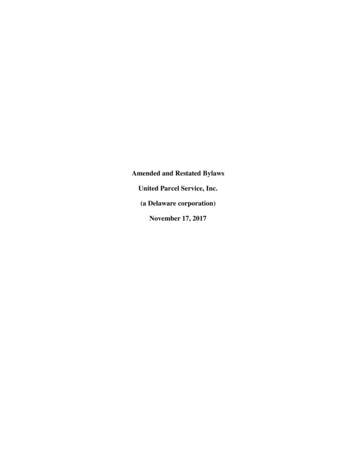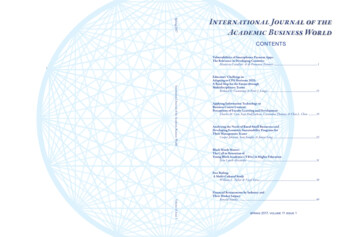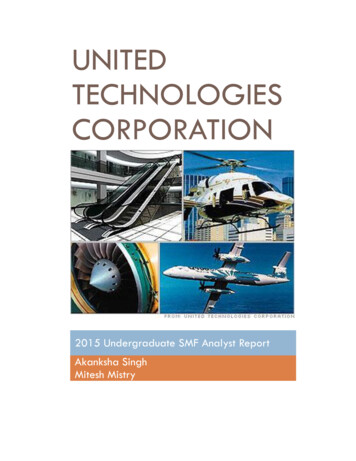
Transcription
UNITEDTECHNOLOGIESCORPORATION2015 Undergraduate SMF Analyst ReportAkanksha SinghMitesh Mistry
United Technologies CorporationUNITED TECHNOLOGIES CORP (UTX)Company SummaryUnited Technologies is a diversified conglomerate with 2014 revenue of 65 billion and businessoperations serving primarily construction and aerospace markets. The company is split into two maindivisions: commercial and aerospace. The commercial side is UTC Building & Industrial Systems,which consists of Otis and UTC Climate, Controls, & Security. Sikorsky, Pratt & Whitney, and UTCAerospace Systems make up the aerospace sector. Otis elevators, Carrier air conditioners, Pratt &Whitney engines, and Sikorsky helicopters are key United Technologies product lines.Key Financial Metrics 134.9439.74%Intrinsic Value:ROIC:1.16.84%Beta:ROA:97.30 – 124.45 3.4152 Week Range:Price/Book: 17.289.55%Price/Earnings:Profit Margin:2.20%4.02%Dividend Yield:Free Cash Flow Yield:106.92B 6.82Market Cap:Earnings Per Share:20.06%915,240,000ROE:Shares Outstanding:RecommendationBuy6.61%Rating:Exp. Annual Return:33.05%Margin of Safety:RationaleUnited Technologies is a cash-generating business that is able to invest in longer-term platforms.Durability and balance are trademarks of UTC’s portfolio. The company is set apart from competitorsthrough management’s consistency and commitment to shareholders. Limited competition, strong brandrecognition, extremely high switching costs, low-cost manufacturing, and strong service revenues makeUTC a dependable, safe addition to any value-driven investment portfolio.UTX vs. S&P 500 (5 years)Page 1
United Technologies CorporationUnited Technologies Corporation2 0 1 5 U N D E RG R A D UAT E S M F A N A LY S T R E P O RTINDUSTRY ANALYSISAerospace/Defense Products & ServicesThe term “Aerospace & Defense” is a generic term that encompasses several different industries. Themajor companies housed under the industries manufacture both commercial and military aircrafts. Mostcommercial aircraft are sold to the world’s airlines. A few are configured for general aviation use,serving nations, companies, or individuals that need large aircraft for transportation outside of thoseavailable to the public. Historically, airlines based in the United States have provided the largest marketfor commercial aircraft. But in recent years, foreign airlines (many subsidized by local governments)have become the major source of orders. The United States military comprises by far, the largest marketfor defense equipment, systems, and services in the world. The companies included in this sector notonly serve America's needs, but often are the suppliers most sought by our allies and friends.United Technologies is the biggest player in the aerospace and defense industry with a market cap of 106.3 billion and the company has three divisions that fall under this industry: Pratt & Whitney, UTCAerospace Systems, and Sikorsky. Boeing Company is the world’s largest aerospace and defensecompany; it is UTC’s biggest competitor and partner in the industry with a market cap of 105.2 billion.Boeing operates in over 90 countries and has three divisions: commercial airplanes, Integrated DefenseSystems (IDS), and Boeing Capital Corporation.In general, the performance of the industry is subject to the cyclical trends of the aerospace market.Since 2001, increased military aircraft demand by the United States government as well as increaseddemand for commercial aircraft has pushed revenues higher for United Technologies and othercompanies.Elevators & HVAC Equipment/ServicingDue to increased urbanization in emerging market countries, especially India and China, the industry forelevators, air conditioning, cooling systems and security systems will expand in the future. The elevatorbusiness is nearly an 18 billion a year industry and is expected to grow at an average of 1.7% a year forthe next 5 years according to IBIS World. The industry is highly fragmented with UTC having the thirdlargest market share of 5.1% with Schindler elevators being the largest company in the industry at 9.2%.The larger companies in the industry, especially Schindler have been focusing on acquiring smallercompetitors in order to consolidate the industry. This industry is reliant on the health of the economy aspeople are more willing to construct commercial buildings when the economy is in an expansion andspend less during recessions. As the world economy improves, the demand for elevators will improvePage 2
United Technologies Corporationalongside, providing opportunities for Otis and UTC in this market. The HVAC and refrigerationbusiness is a 47.6 billion dollar industry which is expected to grow at more than 3% over the next fewyears. UTC is the second largest company in this industry following Ingersoll-Rand. This industry isalso highly fragmented, allowing UTC and other large companies to consolidate smaller companies. Inthe Electronic Access Control System, UTC competes with companies such as Honeywell and Siemenswho both also provide fire safety systems as well. Success in this industry is reliant on advancedtechnologies and strong reputation, especially in commercial uses as companies need to keep proprietaryand valuable information or technologies safe.BUSINESS ANALYSISAerospace BusinessesThe aerospace businesses division of United Technologies is comprised of Pratt & Whitney, UTCAerospace Systems, and Sikorsky. The financial performance of these sectors is directly tied to theeconomic conditions of the commercial aerospace and defense aerospace industries.Pratt & WhitneyPratt & Whitney is among the world’s leading suppliers of aircraft engines for the commercial, military,business jet and general aviation markets. Pratt & Whitney also provides fleet management services andaftermarket maintenance, repair and overhaul services, including the sale of spare parts for largecommercial and military engines. The business’ products are sold principally to aircraft manufacturers,airlines and other aircraft operators, aircraft leasing companies, and the U.S. and foreign governments.Pratt & Whitney’s products and services must adhere to strict regulatory and market-driven safety andperformance standards. The frequently changing nature of these standards, along with the long durationof aircraft engine development, production and support programs, creates uncertainty regarding engineprogram profitability.The development of new engines and improvements to current production engines present importantgrowth opportunities. P&WC is under contract with the U.S. Government’s F-35 Joint Program Officeto develop, produce, and sustain the F135 engine, to power the single-engine F-35 Lightning II aircraftbeing developed by Lockheed Martin. In addition, Pratt & Whitney is currently developing technology,including the PurePower PW1000G Geared TurboFan engine, intended to enable it to power bothcurrently-proposed and future aircraft. PurePower PW1000G engine models have been selected by manybig-name aircraft manufacturers, such as Airbus, Bombardier, and Mitsubishi to add to their airplanes.UTC Aerospace SystemsUTC Aerospace Systems is a leading global provider of technologically advanced aerospace productsand aftermarket service solutions for aircraft manufacturers, airlines, regional, business and generalaviation markets, military, space and undersea operations. The business sells aerospace products toaircraft manufacturers, airlines and other aircraft operators, the U.S. and foreign governments,maintenance, repair and overhaul providers, and independent distributors. UTC Aerospace SystemsPage 3
United Technologies Corporationconducts operations in over 160 locations in 26 countries and has the largest and most comprehensiveaftermarket business in the industry. They were recently awarded a contract to provide submarineacoustic windows for the Naval Undersea Warfare Center. There is much opportunity for growth inemerging countries.SikorskySikorsky, one of the world’s largest helicopter companies, manufactures military and commercialhelicopters and also provides aftermarket helicopter and aircraft parts and services. Current majorproduction programs at Sikorsky include the UH-60M Black Hawk medium-transport helicopters andHH-60M Medevac helicopters for the U.S. and foreign governments, the S-70 Black Hawk for foreigngovernments, the MH-60S helicopter for the US Navy and the MH-60R helicopter for the US andforeign navies. In July 2012, the US Government and Sikorsky signed a five-year multi-service contractfor approximately 650 H-60 helicopters. Sikorsky is increasingly engaging in logistics support programsand partnering with its government and commercial customers to manage and provide logistics andrepair services. This will help the business continue to generate the large cash flows it currently brings infrom all of the product contracts with governments.Commercial BusinessesBuilding & Industrial Systems (BIS)UTC’s Building and Industrial Systems (BIS) division is in prime position to capitalize off of thisgrowth. The BIS division consists of Otis, which produces elevators and escalators, Carrier whichproduces cooling systems and air conditioners as well as Kidde fire and Carbon Monoxide alarms. In2013, the BIS provided UTC with approximately 5.2 billion in operating profit and 29.8 billion insales. For Otis and Carrier products, UTX uses a razor-razor blade business model in which they offerthese products with little markup or at cost to customers. UTC then makes revenues by servicing theseproducts and providing maintenance, which is very lucrative for the company. Once installed intobuildings, Otis elevators and escalators and Carrier air conditioning products are difficult to remove,providing UTC with a reliable stream of income. Customers are locked into UTC’s servicing charges ascustomers need to rely on UTC to maintain these purchases as these products are expensive to take outand replace with a competitors product. UTC unlike its competitors provides maintenance services oncompetitor’s goods as well while some competitors do not. This provides additional revenue for UTC.By servicing their products, UTC also provides convenience to customers of UTC as they have the bestknowledge on how to fix their elevators and air conditioners since they built them in the first place.UTC has been restructuring their divisions in order to save costs and has been able to achieve theirmargin improvements in their Climate, Controls and Security division 2 years earlier. In this division,UTC has been able to provide major contracts to the Hong Kong airport where they are providingsecurity and HVAC (Heating, Ventilation, Air conditioning) equipment. This division is also providingcontrol services to Intergate Manhattan which is the world’s tallest data center. UTC has unveiled theCarrier AquaForce 30XA chiller which is one of the quietest and most efficient on the market and usesless than 30% less refrigerant than traditional designs. This chiller also utilizes aluminum coils whichlimits corrosion that normally occurs. Another one of Carrier’s products is the CO2OLtec system whichPage 4
United Technologies Corporationuses CO2 as a refrigerant and also controls the HVAC system of stores. This system is made especiallyfor grocery stores and can save 30% of the stores energy costs. In addition to these products, Carrier hastailored its refrigeration products countries like India where food waste is high due to the hot climate.The Transicold line is an economical, efficient refrigeration system that is built to be put on light trucks.Kidde has introduced a new Carbon Monoxide alarm that lasts 10 years, longer than any other producton the market.Otis has also been able to receive major projects such as the Hyderabad Metro Rail Project which isIndia’s largest elevator and escalator contract and the Goldin Finance Tower in China. Otis has createdthe new Otis Gen2 Switch elevator which has a battery backup system. This feature is important in theSouth Asian and European markets as there are frequent power outages in these countries and so thiselevator will be able to still run when these power outages occur. This elevator also harnesses the powerof gravity and uses 81% less energy than other elevators which will result in cost savings for customers.GROWTH OPPORTUNITIESAll of United Technologies’ business segments have great opportunities for growth because they areuniquely positioned to benefit from widespread urbanization and the rapidly growing markets,accelerating growth well into the future. In the decades ahead. A much greater portion of the world’spopulation will live in urban centers, driving investment in infrastructure and real estate development.This will create demand for products that contribute to clean, safe, energy-efficient buildings. UTC’scommercial businesses (Otis and UTC Climate, Controls & Security) are well established in the world’sfastest-growing economies and are moving quickly to further localize manufacturing and distributionnetworks to capture new opportunities and better serve customers.A good example is Otis’ actions in China. Otis businesses have prepared for China to become theworld’s largest market for new elevator equipment as well as the world’s fastest-growing service marketin the years ahead. Also, UTC Climate, Controls & Security formed a joint venture to manufacture anddistribute HVAC products in India to expand the company’s presence there.Furthermore, the outlook for the commercial aerospace business is very strong, driven by the need toreplace aging fleets in North America and by increasing demand across Asia. Over the next 20 years,30,000 new aircraft are expected to enter service. UTC is at the forefront in developing the nextgeneration of aircraft to meet this growing global demand.RISKSChina is the largest market for new accounts as it is a large country where urbanization is resulting inmillions of people moving from farms to cities. 20% of Otis’ revenue comes from the Chinese marketand given growing concern over a potential housing bubble in China, if this bubble were to be in factreality, this would adversely affect UTC’s revenues. UTC would be unable to make its revenues fromservicing these products and so this is a large risk that the firm faces. Another risk that UTC faces is thePage 5
United Technologies Corporationreduction in government spending in the U.S. and by governments around the world on military aircraft.In 2013, 19% of revenues came from Military Aerospace sales and so large reductions in spending willresult in a material change in the success of UTC. Due to UTC’s reliance on innovation in order todistinguish itself from competitors, UTC will need to continue to provide products and technologieswith practical uses, especially since Research and Development expenditures were 4.7 billion last year.Because of the competitive nature of the businesses that UTC is in with large rivals such as GE andRolls-Royce, and Schindler, UTC may face significant loss in market share should UTC lose focus onproducts that customers want or create products that are inferior to those of rivals. As, UTC may need tofocus on inorganic growth, or growth through acquisitions, it is important that the firm doesn’t destroyvalue by paying more for a company than what it is worth to UTC. Also, the company needs to be ableto integrate new companies into the pre-existing structure effectively or else projected synergies will failto materialize.VALUATIONWe valued UTC using a DCF method in which a 4% growth rate of FCF was used for 10 years afterwhich a terminal growth rate of 3% was used. The 4% growth rate was determined by taking the NetOperating Profit Less Adjusted Taxes (NOPLAT) in 2013 and dividing that by the capital investedcapital or the total operating assets of the company in order to find the Return on Invested Capital(ROIC). The ROIC was then multiplied by the net invested capital as a portion of NOPLAT in order todetermine a growth rate of 4%. The 3% terminal growth rate is utilized as this is the historical growthrate in GDP of the U.S. and a discount rate of 10% is used as this is the historical discount rate whenaccounting for the historical returns of the risk-free U.S. Treasury and the historical stock marketreturns. The enterprise value of UTC was determined and then the equity value was determined bysubtracting debt and adding cash. The Intrinsic value was determined to be 126.21 and the price at thetime we bought UTC was 101.42. After accounting for share repurchases of 1.2 billion a year, in 5years the intrinsic value of UTC would be 134.94.Page 6
United Technologies CorporationAPPENDIXExhibit 1: UTX DCF ValuationUTC ValuationOperating IncomeAdd: Restructuring ChargesDeferred TaxesAdjusted Operating IncomeLess: Taxes (26.9%)NOPLAT Add: DepreciationAdd: Stock compensation costGross CF 9,209.00481.009,690.002,238.007,452.00Change in OWCCapital ExpendituresGross InvestmentNon-controlling InterestFree Cash Flow% of NOPLATWorking Capital2013Total Current Assets 29,442.00Less: Cash & Equivalents 4,619.00Adjusted: TCA 24,823.00Total Current Liabilities 22,800.00Less: ST Debt 500.00Adjusted: TCL 22,300.00NOWC 2,523.00Change1,821.00275.009,548.00 1,821.00 4,791.0023,786.001,624.0022,162.002,629.00(106.00) ROICNOWCNet PP&EOther Assets & unconsol. AffiliatesInvested CapitalGoodwill & Other IntangiblesInvested Capital w/ GWROIC w/o goodwillROIC w/ goodwill 39.00Net Invested CapitalChange in WCCapital ExpendituresChange in other Op. AssetsNet Invested CapitalRetention Ratio201301821663 24840.3339.74%11.93%Retention ratio33%g4.0%Page 7
United Technologies CorporationWACCgTV gUnited Technologies Corp.FCFDiscount FactorPVFCF Enterprise ValueLess: DebtCash Cash Eq.Equity ValueIntrinsic Value 020137,339.00 7,339.00 120147,630.97 0.91 6,944.18 22015320168,250.21 0.75 6,187.65 420178,578.42 0.68 5,833.33 131,134.35(20,241.00)4619115,512.35126.21Share Repurchase after 5 yearsCurrent Share PriceShares RepurchasedTotal Shares OutstandingShares Outstanding after 5 yearsIntrinsic Value after 5 yearsPage 87,934.55 0.83 6,585.67 1134.94520188,919.70 0.62 5,530.21 10.00%3.98%3.00%620199,274.55 0.62 5,750.22 720209,643.52 0.56 5,400.37 8202110,027.16 0.51 5,113.85 9202210,426.07 0.47 4,900.25 10202310,840.85 0.42 4,553.16 112024159,515.350.4266,996.45
Building & Industrial Systems (BIS) UTC's Building and Industrial Systems (BIS) division is in prime position to capitalize off of this growth. The BIS division consists of Otis, which produces elevators and escalators, Carrier which produces cooling systems and air conditioners as well as Kidde fire and Carbon Monoxide alarms. In


